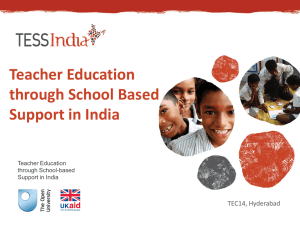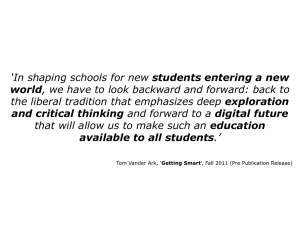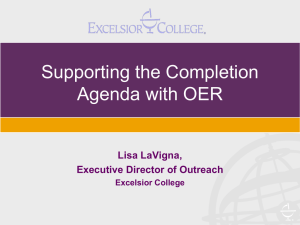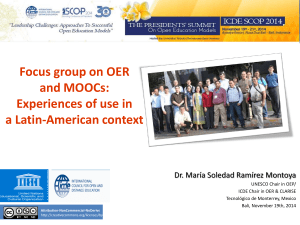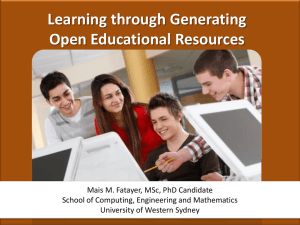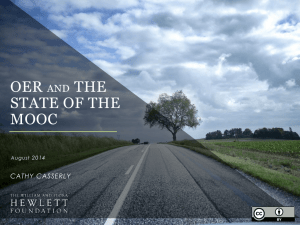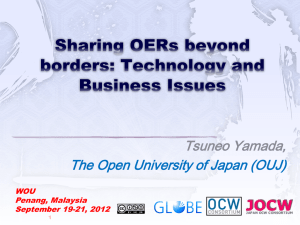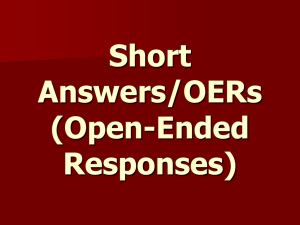OER - Information Technology at Purdue
advertisement
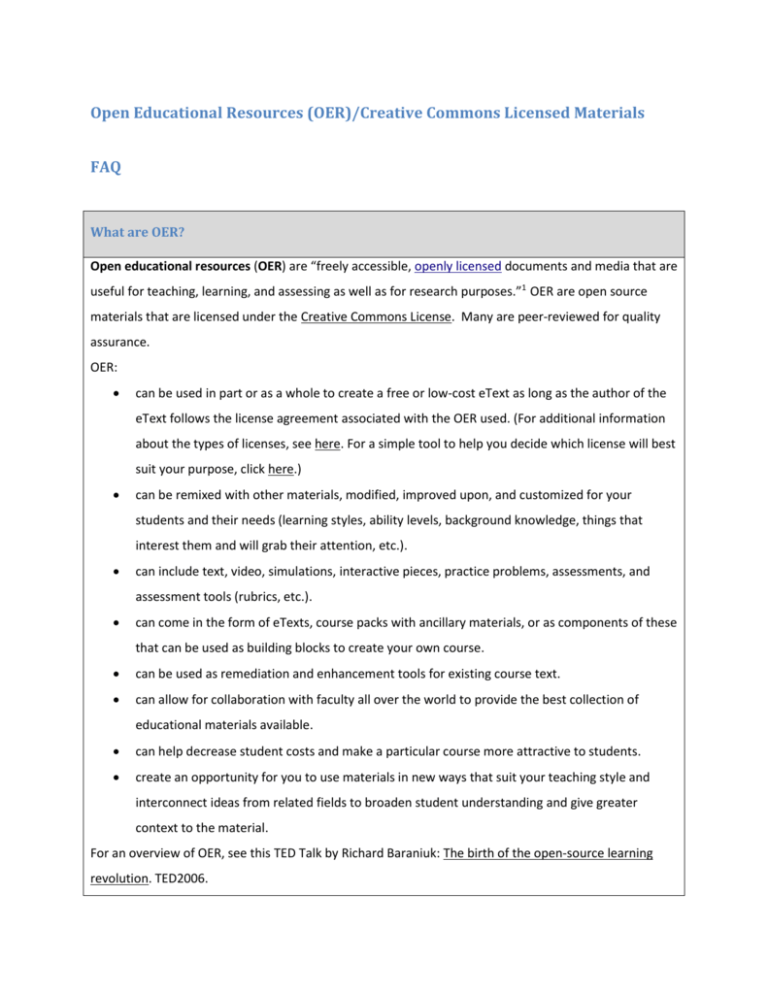
Open Educational Resources (OER)/Creative Commons Licensed Materials FAQ What are OER? Open educational resources (OER) are “freely accessible, openly licensed documents and media that are useful for teaching, learning, and assessing as well as for research purposes.”1 OER are open source materials that are licensed under the Creative Commons License. Many are peer-reviewed for quality assurance. OER: can be used in part or as a whole to create a free or low-cost eText as long as the author of the eText follows the license agreement associated with the OER used. (For additional information about the types of licenses, see here. For a simple tool to help you decide which license will best suit your purpose, click here.) can be remixed with other materials, modified, improved upon, and customized for your students and their needs (learning styles, ability levels, background knowledge, things that interest them and will grab their attention, etc.). can include text, video, simulations, interactive pieces, practice problems, assessments, and assessment tools (rubrics, etc.). can come in the form of eTexts, course packs with ancillary materials, or as components of these that can be used as building blocks to create your own course. can be used as remediation and enhancement tools for existing course text. can allow for collaboration with faculty all over the world to provide the best collection of educational materials available. can help decrease student costs and make a particular course more attractive to students. create an opportunity for you to use materials in new ways that suit your teaching style and interconnect ideas from related fields to broaden student understanding and give greater context to the material. For an overview of OER, see this TED Talk by Richard Baraniuk: The birth of the open-source learning revolution. TED2006. Why should I use OER? David Wiley, PhD, Brigham Young University, Instructional Psychology and Technology gives an excellent TED Talk on Open Education and the Future that provides an overview of the value of OER. The Open Courseware Consortium and other OER supporters suggest that OER can benefit education by: Minimizing student textbook costs Cutting out the publishers to allow for greater flexibility of text and quicker publication for new research and ideas Providing “examples of excellence for faculty and students” 2 Promoting “partnerships, collaborations, and recognition” 2 Creating an educational repository that allows for building upon others’ ideas 2 Promoting transparency to develop user trust and respect Providing a vehicle for contributing to faculty members’ discipline3 2 Where can I find high-quality OER materials? ITaP's Innovations in Technology and Learning team can help you identify appropriate materials for your needs. Please contact Robby Crain for additional information. Here are additional resources for highquality OER materials: MERLOT (Multimedia Educational Resource for Learning and Online Teaching) is a program of the California State University System partnering with education institutions, professional societies, and industry. Its database allows the user to search by keywords, community, category, language, material type, and audience. The resources can be sorted by peer review, editor review, member comments, and the availability of additional ancillary materials. The University of Minnesota's Open Textbook Library contains complete and openly licensed textbooks that can be edited to fit your course and the needs of your students. UMN supports faculty review of its textbooks. Rice University offers students free peer-reviewed textbooks written by professional content developers. Although the selection is limited at this time, the resources available are comprehensive and include supplemental resources such as videos, interactive resources, PowerPoint presentations, and assessment materials. OER Commons provides OER textbooks for various subject areas and skill levels. What are the limitations or concerns with OER, and what solutions do you suggest? Support A recent survey of faculty perceptions of the barriers to adopting OER include: Difficulty in searching for OER Lack of a comprehensive catalog Concerns about the time to learn and use OER Inadequate mapping to learning outcomes Lack of support for non-local curriculum ITaP's Innovations in Technology and Learning team can help you identify appropriate materials for your needs and support you through OER adoption. They can help streamline the process and even provide an incentive for you to create an eText for your course. Please contact Robby Crain for additional information. Text Quality and Supplemental Materials Additional issues include: Unbundled pieces that may not cover everything and need to be evaluated for scope and sequence Lack of ancillary materials such as homework sets and assessments Lack of teacher editions Lack of faculty ratings and comments Lack of assessments that tie into grade book Accessibility OER materials are increasingly being bundled to include videos, PowerPoints, simulations, assessments, and teacher editions. These bundles are often peer-reviewed for content, scope, and sequence. As more faculty become aware of and contribute to OER, these repositories will grow. Some faculty are using LON-CAPPA to create their own homework and test repositories that will tie in to an LMS. Please contact Robby Crain for additional information. Accessibility is a high priority at Purdue, and we can help you make sure that your materials are accessible to all of your students. How can I support OER? Create your own OER. Use a Creative Commons License to retain copyright while allowing others to copy, distribute, and expand upon your work for non-commercial use. Retain your rights to reproduce, distribute, and create derivative works in digital and print form by adding an Author’s Addendum to your publishing contract. Review an open textbook to ensure the quality of OER. You can support the Open Textbook Library at UMN and help your peers evaluate the textbooks by writing a review of an open textbook in your field. Only experts like you can determine quality. Email open@umn.edu to get started. Resources: 1 Open Educational Resources. Wikipedia http://en.wikipedia.org/wiki/Open_educational_resources. 2 Forward, Mary Lou. Open sharing, global benefits [PowerPoint/PDF]. Retrieved from http://www.bg.pw.edu.pl/iatul2011/proceedings/presentation/Forward_M.pdf 3 Baraniuk, Richard. On open source learning. Ted Talk. Retrieved from http://www.ted.com/talks/richard_baraniuk_on_open_source_learning 4 Ferreira, Jose. OER and the future of publishing. EdSurge. Retrieved from https://www.edsurge.com/n/2014-08-10-oer-and-the-future-of-publishing

